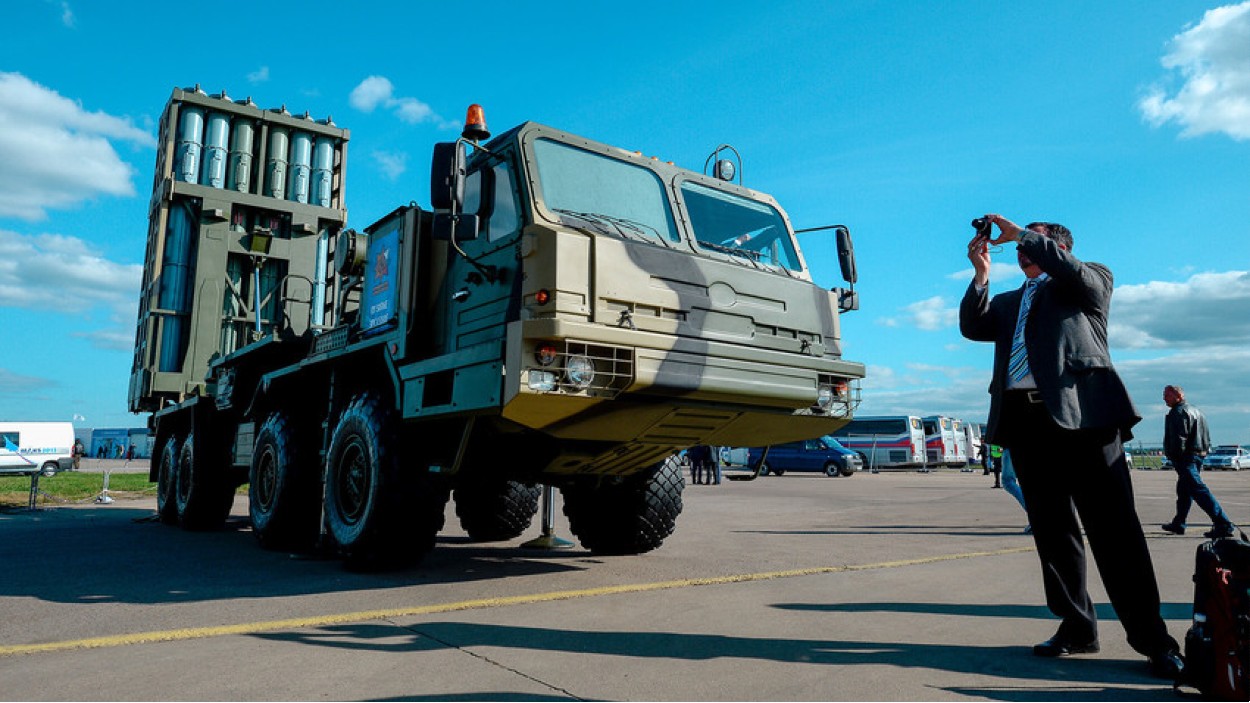Months after its first appearance near Ukraine in August last year, Russia’s vaunted S-350 Vityaz air defense system has achieved an unprecedented milestone by shooting down a Ukrainian aircraft in “automatic mode.”
Russia ‘Smashing’ 330 Ukrainian UAVs Per Day; UK Report Says Russian Electronic Warfare ‘Wreaks Havoc’ On Kyiv
The Russian S-350 Vityaz anti-aircraft missile system shot down Ukrainian aircraft in the special operation zone in a fully automatic mode without an operator’s participation. Russian news agency RIA Novosti reported that this mode of operation was tested in combat conditions for the first time in the world.
“The Vityaz anti-aircraft missile system in the Special Military operation zone for the first time in the world in combat conditions performed fully automatic, without an operator’s participation, detection, tracking, and defeat of Ukrainian air targets. The system’s missiles shot down several Ukraine combat aircraft and drones,” the agency’s interlocutor said.
He added that the combat crew, at the same time, only controlled the operation of the complex.
An unnamed source accessed by RIA Novosti explained, “The automatic mode was implemented based on the principle that a person does not cancel the decisions of the artificial intelligence elements of the complex within the framework of the emerging air combat situation, that is, the operator simply did not interfere in the operation of the complex, thus confirming the operation algorithm chosen by the machine.”
The interlocutor stated that “Vityaz” simultaneously worked in active and passive radar modes. This method essentially increases the noise immunity of the complex and its ability to detect and classify targets. The development comes months after the system was first deployed along the frontlines.
In August 2022, visual evidence that surfaced on social media suggested that the S-350 Vityaz air defense system was deployed at an airbase less than 40 miles from the Ukrainian border days after Ukraine started pounding Russian military facilities in Crimea, including the infamous attack on the Saki Air Base in southern Crimea.
Stills from a new Russia MoD video on Su-25 operations against Ukraine. Several elements of a S-350 SAM system can be seen in the background, including a 50N6A fire-control radar, 96L6-TsP acquisition radar, & 2 launchers: 50P6 TEL(s) and/or 50P6T LLV(s).https://t.co/hOJizOJe5C pic.twitter.com/87HEBhee9f
— Guy Plopsky (@GuyPlopsky) August 14, 2022
The S-350 Vityaz air defense system elements were first spotted in a video released by the Russian Ministry of Defense (RuMoD). While the said video aimed to showcase the close air support activities of its Su-25 Frogfoot aircraft at an undisclosed airbase close to Ukraine, it was the S-350 that attracted the most eyeballs.
The appearance of the S-350’s components is what’s most intriguing. A 50N6A fire-control radar, a 96L6-TsP acquisition radar, as well as two missile launchers—which could be examples of the 50P6 transporter-erector-launcher (TELs) and the strikingly similar 50P6T launcher/loader vehicle were identified by defense analyst Guy Plopsky, who tweets as @GuyPlopsky.
At the time, military watchers noted that the video was most likely shot at Taganrog Air Base, close to the same-named port city in Rostov Oblast on the Sea of Azov. Several online reports have hinted that the S-350 has been widely involved in the so-called ‘Special Military Operation’ zone.

What Do We Know About The Russian S-350 Vityaz?
The S-350 Vityaz is a mobile multi-channel anti-aircraft missile system developed by the Almaz-Antey concern for the anti-aircraft missile forces of the Russian Aerospace Forces. It is designed to protect state, administrative, industrial, and military facilities and groupings of troops from attacks by modern and advanced air attack weapons.
The development work on the system began in the early 1990s, and its first flight test took place in 2013, and the Russian military received its first batch of S-350 systems in December 2019.
According to several accessible sources, the complex can strike ballistic targets up to a range of 25 kilometers and aerodynamic air targets, such as aircraft, drones, cruise missiles, and other devices, at a maximum range of 120 to 150 kilometers. Targets struck by Vityaz missiles can move at a top speed of two kilometers per second.
Earlier, on February 15, a representative of the design bureau of the Almaz-Antey Air Defense Concern stated that the S-350 Vityaz could be integrated into foreign air defense systems. The representative highlighted features like the complex’s all-aspect, enhanced firepower, higher ammunition capacity for anti-aircraft guided missiles (four times greater than that of the S-400), and increased survivability.
Not just that, Military expert Viktor Murakhovsky called the Vityaz the killers of American Tomahawk missiles and European Storm Shadow. At the time, Murakhovsky made a case for connecting the air defense systems Prometheus, Vityaz, Pantsir, and others into a unified network to protect Russia by an “umbrella” that would almost be impenetrable.
Another Russian military expert Alexander Mikhailov said the Russian S-350 Vityaz was much more accurate than the Patriot missile defense system, which is now operational in Ukraine. He told the Vityaz anti-aircraft missile system was comparable to the US-made Patriot missile system in terms of functional characteristics, but Russian missiles fly faster and have the capability of striking low-flying targets.
“The Patriot does not shoot down targets flying at an altitude of lower than 100 meters, whereas the Vityaz knocks out targets at an altitude of 10 meters and higher,” the Russian asserted.
- Contact the author at sakshi.tiwari9555(at)gmail.com
- Follow EurAsian Times on Google News




